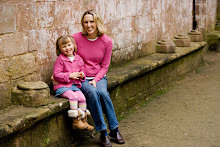When we got into Bath, we headed straight to the city center where the Roman Bath House and Bath Abbey are located. While we were trying to decide where to go first, we got to watch a street performer who juggled flaming torches while riding on a unicycle!
 Not a bad way to start our day. After the show, we got some lunch at a local pasty store (I promise to blog someday about pasties... basically, it's a meal in a pie pastry... warm, filling, and delicious!), and enjoyed it sitting on a bench in the middle of the city square.
Not a bad way to start our day. After the show, we got some lunch at a local pasty store (I promise to blog someday about pasties... basically, it's a meal in a pie pastry... warm, filling, and delicious!), and enjoyed it sitting on a bench in the middle of the city square. After lunch, we headed to the Roman Baths.
After lunch, we headed to the Roman Baths.  While waiting in line (or "in the queue"), we enjoyed the view of the Abbey next door.
While waiting in line (or "in the queue"), we enjoyed the view of the Abbey next door. Back to the Baths.... As I mentioned before, when the Romans settled in Bath around 75AD, they built a bath house making good use of the natural hot springs in the area. For the greater part of the 2000 years since it was built, the Baths lay in ruins under the ground, unknown to the people living above. But now, they have been excavated restored to its former appearance.
Back to the Baths.... As I mentioned before, when the Romans settled in Bath around 75AD, they built a bath house making good use of the natural hot springs in the area. For the greater part of the 2000 years since it was built, the Baths lay in ruins under the ground, unknown to the people living above. But now, they have been excavated restored to its former appearance. This stone shows the earliest recorded date for the building of the baths, 76AD.
This stone shows the earliest recorded date for the building of the baths, 76AD.  Here is a model of what the baths originally looked like,
Here is a model of what the baths originally looked like,  and how they were built upon later on.
and how they were built upon later on. Adjunct to the baths was a Roman Temple to the goddess Minerva. Here is a gilt bronze head of Minerva,
Adjunct to the baths was a Roman Temple to the goddess Minerva. Here is a gilt bronze head of Minerva,  and this is a picture of the temple pediment that they are re-assembling.
and this is a picture of the temple pediment that they are re-assembling.  These are the original stairs up to the temple.
These are the original stairs up to the temple. Here is the Great Bath from over-head where the statues of Roman govenors look on,
Here is the Great Bath from over-head where the statues of Roman govenors look on,

 and from pool-side.
and from pool-side. 
 The bath complex also included the sacred spring,
The bath complex also included the sacred spring,  the spring overflow,
the spring overflow,  plunge pools,
plunge pools,  sauna rooms, and changing rooms with heated floors! The furnace was under the base floor, and then they would build another floor on top of these pilings. Heated floors! Ingenious!
sauna rooms, and changing rooms with heated floors! The furnace was under the base floor, and then they would build another floor on top of these pilings. Heated floors! Ingenious! Apparently the Romans would come to the baths daily. They were very keen on staying clean, as well as staying in the social scene.
Apparently the Romans would come to the baths daily. They were very keen on staying clean, as well as staying in the social scene.It was a GREAT tour, and my favorite part of our whole trip.
After we left the Baths, we decided to take a walk around the city. We started by walking across Pulteney Bridge. Pulteney Bridge is one of the few bridges left in Europe that is lined with shops and restaurants. This is a picture of the road across the bridge,
 and from the side.
and from the side.  We then took a stroll up to the Circus. The Circus is a circular space surrounded by three sections of townhouses.
We then took a stroll up to the Circus. The Circus is a circular space surrounded by three sections of townhouses.  They were built in the mid-1700s, and exemplify a Georgian-style of architecture. This is a picture of the near-by Royal Crescent.
They were built in the mid-1700s, and exemplify a Georgian-style of architecture. This is a picture of the near-by Royal Crescent.  As we headed back towards the city-center, we came across the Jane Austen center.
As we headed back towards the city-center, we came across the Jane Austen center.  I know all of you Austen fans will kill me for not going in, but I know you would also agree that it probably wasn't the most husband-and-three-young-children-friendly kind of places to visit.
I know all of you Austen fans will kill me for not going in, but I know you would also agree that it probably wasn't the most husband-and-three-young-children-friendly kind of places to visit. Bath was a really incredible city to visit. It had it all: the history, the incredible architecture, chic shops, even flame-juggling unicyclists. A great outing for the whole family.






























